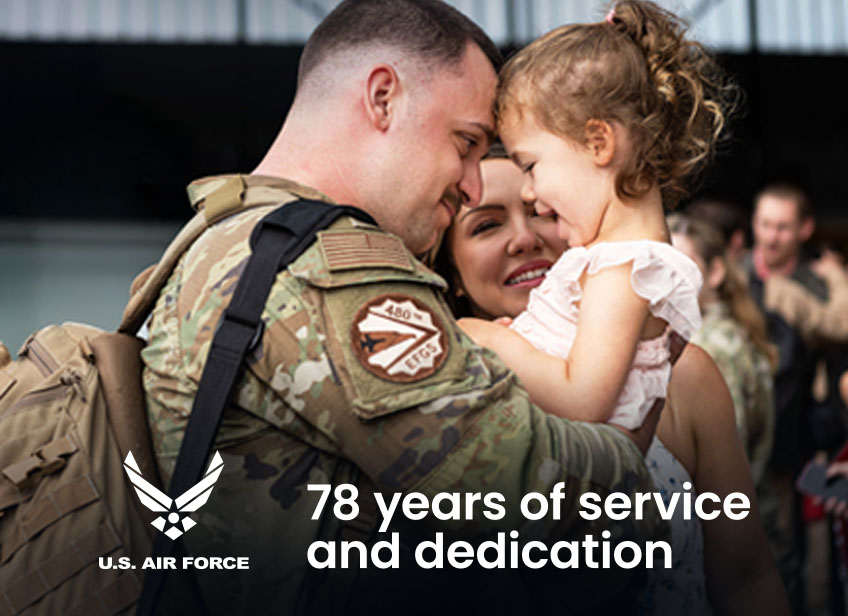By Les Kodlick
A Nation Powered by Civilians
Seventy-eight years ago today, the United States Air Force was born as a separate service branch of the U.S. military. Since then, Airmen have flown faster, farther, and higher than ever imagined. They have guarded the skies, supported allies, and projected American strength across the globe. But behind every aircraft takeoff, every satellite positioned, and every innovation tested stands a force often overlooked: civilians.
From the federal workforce that keeps our nation running, to the neighbors who surround our bases and installations, civilians form the foundation on which America’s defense and democracy stand. Today, as we honor the Air Force’s birthday, it is fitting that we thank every service member and offer a salute of gratitude to the civilians whose daily contributions make the mission possible.
Thanks to Federal Civil Servants
Let’s begin with those who raise their right hand, not to wear a uniform, but to serve as federal employees. Across every department and agency — from the Department of Agriculture to the FAA, GSA, TSA, VA, and countless others — civil servants carry out missions that enable our nation to function.
Consider the weather forecasters at the National Oceanic and Atmospheric Administration, whose data informs pilots before they take off. Think of the FAA controllers who keep air traffic safe and efficient, guiding military and civilian aircraft alike. Or the Department of Veterans Affairs staff who care for those who once wore the uniform, helping them heal, find work, and lead fulfilling lives.
These professionals don’t always receive headlines, but they deserve them.
Thanks to the Department of the Air Force Civilians
Within the Department of the Air Force alone, more than 170,000 civilians serve alongside active-duty and reserve Airmen and Guardians as part of the Air Force Civilian Service. They are engineers ensuring aircraft safety, scientists advancing space technology, contract specialists keeping acquisitions on track, and instructors teaching the next generation of Airmen.
Walk through any Air Force or Space Force installation and you’ll find civilians mentoring young officers, maintaining runways, coding advanced software, and troubleshooting critical systems. They may not wear the uniform, but they share the mission and live the values of integrity, service, and excellence. Many dedicate decades of their lives to this quiet form of national service, often becoming the institutional memory that connects one generation of Airmen to the next.
Thanks to Community Civilians
Then there are the civilians who may never set foot inside the Pentagon or sign a federal contract but nonetheless serve. These are the men and women who live in the communities that surround our installations. They are teachers educating the children of military families, pastors offering comfort, business owners extending military discounts, and volunteers running food banks or coaching youth sports teams.
When an Airman deploys overseas, it is often neighbors who step in to help with childcare, mow the lawn, or simply check in with words of encouragement. In times of crisis, these community ties sustain families and remind service members that they are never alone.
Stories of Service Beyond Uniforms
Consider the story of a schoolteacher near Joint Base San Antonio, Texas, who tutors military children struggling with their coursework after yet another move. Or the mechanic outside Hill Air Force Base, Utah, who makes sure a young Airman’s car is ready for a long drive to see family. Or the nurse at a small-town clinic near Offutt Air Force Base, Nebraska, who treats a retiree with the same care and respect given to any active-duty member.
These acts may seem ordinary, but they are extraordinary in their collective impact. They form the invisible web of support that allows Airmen and Guardians to focus on their missions, knowing their families and communities are in good hands.
A Shared Commitment
It’s easy to picture the Air Force in terms of jets, satellites, and cyber networks. But the real engine of American defense is people — uniformed, civilian, and community alike — working together with pride, integrity, and commitment.
So, on this 78th birthday of the United States Air Force, let us pause to say thank you. Thank you to the 170,000 Department of the Air Force civilians who strengthen the mission every day. Thank you to the millions of government employees across agencies who keep this country moving forward. And thank you to the civilians in every town and city who extend their hands in support of those who serve.
A Call to Gratitude
The next time you encounter a veteran, a government worker, or a community member who serves others, take a moment to thank them. If you wear the uniform, consider offering them a salute of gratitude. They have earned it.
Because in the end, defending America is not the work of a few. It is the shared responsibility of a nation, uniformed and civilian, standing together. And that is the true strength of the United States of America.
About the Author
Les Kodlick is MarCom Group’s Chief Communication Officer. Before joining the company, the brigadier general served for nearly 30 years until retiring as the Air Force’s Director of Public Affairs. A recognized leader in strategic communication and crisis response, he has successfully led organizations through product launches, branding initiatives, natural disasters, and major crises. He has formulated and implemented communication strategies for major programs and products, and represented several Fortune 500 clients while working with an international public relations firm in New York City.


